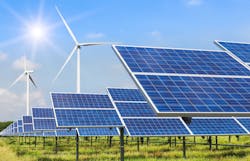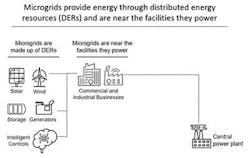Microgrids are a key part of these decentralized technologies. The term microgrid can be intimidating, because it may mean different things to different people, so let’s break it down and highlight some of the benefits.
Let’s cover four common questions and answers about living on microgrids to boost your energy IQ.
No. #1: What is a microgrid?
A microgrid is a local energy system capable of producing, potentially storing and distributing energy to the facilities within the network. Microgrids can be made up of several different assets, also called distributed energy resources (DERs). Common DERs used to generate power are solar photovoltaics (PV), wind turbines and power generators. Energy storage systems, intelligent controls and management software are other elements of the system that provide further functionality to the microgrid. Microgrids can be connected to the centralized grid or completely off-grid and self-sustaining. With the obvious need for continuous, reliable power, healthcare facilities can be good applications for grid-connected microgrids. Remote mining sites that need a lot of energy can be great applications for off-grid microgrids.
No. #2: What is the difference between microgrids and centralized generation?
The difference can be summed up in two words; proximity and resiliency.
Microgrids are near facilities they power. On the other hand, electricity, in centralized power generation, is produced in central power plants that could be hundreds to thousands of miles away from facilities being powered. This proximity of microgrids reduces losses in energy transmission and the significant cost of installing new transmission and distribution networks.
Most microgrids deliver improved energy resiliency through redundant DERs, a combination of solar PV, natural gas or diesel power generators and energy storage systems. Depending upon the microgrid design, facilities can still be powered even if any of these DERs fail. In comparison, a failure in a power plant could put businesses in the dark.
No. #3: How does a microgrid work?
Intelligent controls and management software are at the core of microgrids. Many control systems can track the energy needs of the facility and determine how to supply the needed energy. These control systems consider and evaluate factors such as cost, fuel supply, weather and energy load required to decide which DERs to utilize.
As mentioned, microgrids can be made up of many different assets. The control systems are the key element to manage dispatching the best asset based on these factors. Finally, some microgrids also feature energy storage systems to capture the energy produced at one time for use later.
No. #4: Why do we need microgrids?
Sustainability
As more businesses focus on sustainability and deploy renewable energy sources such as solar PV, microgrids come to help by integrating these renewable sources into the energy infrastructure. These renewable sources become a physical part of the microgrid and the intelligent controls manage their utilization.
Economics
Microgrids feature intelligent controls that can help businesses save money and improve economics. These systems can monitor the cost of energy from different DERs and utilities, then make choices on activating the lowest cost option. They also maximize the contribution of different sources. For example, when the wind isn’t blowing, the energy storage system can be activated to utilize the energy stored from when it was blowing to meet the load. Microgrids also help businesses participate in demand response and demand charge management programs to lower their costs.
Resiliency
Microgrids improve the resiliency of the local energy infrastructure by adding redundant DERs, which provide energy to the businesses. For a grid-tied microgrid, this means local DERs, ranging from solar PV to power generators, can continue to power the businesses and facilities during a utility outage.
Microgrids will continue to play a key role in our energy future. Businesses can evaluate the relevancy of microgrids per their unique needs as a part of their broader energy management strategy.
Aytek Yuksel is content marketing director at Cummins.









